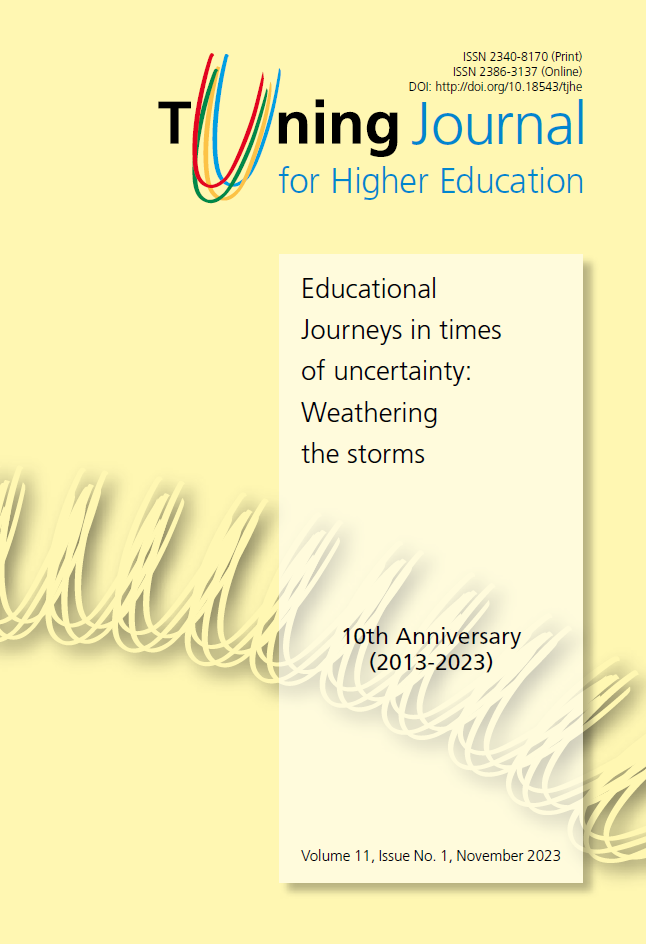The use of the video format as a teaching guide in university studies
Abstract
This article presents a pilot experiment on subjects from three Social Sciences degrees at two public Andalusian universities. The aim is to analyze the teaching guides and their presentation to students as a means of communicating with them, primarily through the video format instead of the conventional written format. To this end, attractive, clear and relatable video teaching guides have been developed to present to students, aware of the success of short videos dominating digital social networks, especially among younger age groups. A knowledge test was given to 99 students on the subject contents, as well as a satisfaction test; the following information was processed through the SPSS program. The main conclusion is that students have a high degree of satisfaction and a better knowledge of the new video guide format than the conventional written model.
Received: 21 July 2022
Accepted: 20 June 2023
Downloads
References
Altman, Howard B. 1989. “Syllabus shares ‘What the Teacher Wants’.” The Teaching Professor 3: 1-2.
ANECA. 2012. “Guía de apoyo para la elaboración de la Memoria de Verificación de los títulos oficiales universitarios.” Accesed May 1, 2021. https://www.uchceu.es/docs/calidad/tramite-titulaciones/guia-ANECA.pdf
Bailey, Rosemary A. 2008. Diseño de Experimentos Comparativos. Cambridge: Prensa de la Universidad de Cambridge.
Birdsall, Melanie. 1989. Writing, Designing, and Using a Course Syllabus. Boston: Northeastern University, Office of Instructional Development and Evaluation.
Castro-Higueras, Antonio. 2019. “Videoguía docente de Técnica y Edición Multiplataforma.” Accessed May 1, 2022. https://www.youtube.com/watch?v=jBf88seAdiY.
Cheung, Wing Sum, Khe Foon Hew, and Connie Siew Ling Ng. 2008. “Toward and understanding of why students contribute in asynchronous online discussions.” Journal of Educational Computing Research 38(1): 29-50. http://doi.org/10.2190/EC.38.1.b.
Cuéllar, Angélica, and Luis Navarro. 2019. “Formar y enseñar Sociología: la flexibilidad de la teoría y el valor diferencial de la mirada sociológica.” Acta Sociológica 78: 9-37. https://doi.org/10.22201/fcpys.24484938e.2019.78.70698.
De Aguilera, Miguel, Pedro Farias, and Antonio Baraybar. 2010. “La comunicación universitaria. Modelos, tendencias y herramientas para una nueva relación con sus públicos.” Revista ICONO14 Revista científica de Comunicación y Tecnologías emergentes 8(2): 90-124.
de Lima Lopes, Juliana, Rui C. Negrão Baptista, Camila Takao Lopes, Marina Bertelli Rossi, Elizabeth A. Swanson, and Alba Lucía Bottura Leite de Barros. 2019. “Efficacy of a video during bed bath simulation on improving the performance of psychomotor skills of nursing undergraduates: A randomized clinical trial.” International Journal of Nursing Studies 99. https://doi.org/10.1016/j.ijnurstu.2019.04.001.
Dennen, Vanessa P. 2011. “Facilitator presence and identity in online discourse: Use of positioning theory as an analytic framework.” Instructional Science 39(4): 527–541. http://doi.org/10.1007/s11251-010-9139-0.
Díez Ros, Rocío, Bárbara M. Aguilar Hernández, Isabel M. Gómez Triguero, Inés Lozano Cabezas, Marcos J. Iglesias, Teresa Pérez Castelló, and María I. Vera Muñoz. 2016. “Inclusión de la perspectiva de género en las guías docentes de asignaturas de Didáctica.” Paper presented at XIV Jornadas de Redes de Investigación en Docencia Universitaria: investigación, innovación y enseñanza universitaria: enfoques pluridisciplinares, Alicante, 2016. Alicante, Universidad de Alicante. http://rua.ua.es/dspace/handle/10045/57093.
Dong, Chaoyan, Naresh Satyanarayan Kumar, Vaikunthan Rajaratnam, and Yanika Kowitlawakul. 2015. “How Health Profession Educators Produced Videos: Three Examples.” Medical Science Educator 25(4): 383-386. https://doi.org/10.1007/s40670-015-0170-2.
European Higher Education Area. 1999. The Bologne Declaration. http://www.ehea.info/media.ehea.info/file/Ministerial_conferences/02/8/1999_Bologna_Declaration_English_553028.pdf.
Giner, Salvador. 2007. Escritos sociológicos. Madrid: Centro de Investigaciones Sociológicas.
Hinkelmann, Klaus, and Oscar Kempthorne. 2008. Diseño y Análisis de Experimentos, Volumen I: Introducción al Diseño Experimental (2ª ed.). New Jersey: Wiley.
Hootsuite. 2021. Digital 2021. Global overview report. https://wearesocial.com/digital-2021.
Lekue, Pablo, Ainhoa Gómez, and Amaia Andrieu. 2016. “Percepción del alumnado de la Facultad de Educación y Deporte (UPV/EHU) sobre las guías docentes de Educación en las Artes Visuales.” Observar 10(2): 135-146. https://www.observar.eu/ojs/index.php/Observar/article/view/73.
Lowther, Malcom A., Joar S. Stark, and Gretchen G. Martens,. 1989. Preparing Course Syllabi for Improved Communication. Ann Arbor: University of Michigan, National Center for Research to Improve Post-secondary Teaching and Learning.
Mayer, Richard E. 2001. Multimedia learning. New York: Cambridge University Press.
Miller, Scott, and Stephen Redman. 2010. “Improving instructor presence in an online introductory astronomy course through video demonstrations.” Astronomy Education Review 9(1): 1-7. http://doi.org/10.3847/AER2009072.
Monedero, Carmen R., Antonio Castro Higueras, and Navarro Ardoy, Luis. 2019. “Adaptación de las guías docentes a las tendencias de consumo de contenidos entre estudiantes de universidad: el vídeo social.” Libro de Actas del Congreso CUICIID. https://cuiciid.net/wp-content/uploads/2020/06/Libro-de-actas-2019-completo-1.pdf.
Nagy, Judit T. 2018. “Evaluation of Online Video Usage and Learning Satisfaction: An Extension of the Technology Acceptance Model.” The International Review of Research in Open and Distributed Learning 19(1): 1-26. https://doi.org/10.19173/irrodl.v19i1.2886.
Navarro Ardoy, Luis, Antonio Castro Higueras, and Carmen R. Monedero Morales. 2020. “Análisis de los recursos audiovisuales y redes sociales para promocionar el Grado en Comunicación Audiovisual. La sorprendente paradoja de las universidades españolas.” In Lo audiovisual bajo el foco del siglo XXI, edited by Mónica Viñarás, Ana G. Cano and Ricardo Casañ, 403-416. Valencia: Tirant lo Blanch.
Paniagua, Francisco J., and Bernardo J. Gómez. 2012. “Hacia la comunicación 2.0. El uso de las redes sociales por parte de las universidades españolas.” Revista ÍCONO14. Revista científica de comunicación y tecnologías emergentes 10(3): 346-364. https://doi.org/10.7195/ri14.v10i3.473.
Perona, Javier S. 2020. “10 consejos sencillos para ilustrar tus presentaciones.” malnutridos.com, 22 de febrero. https://malnutridos.com/2019/10/30/10-consejos-sencillos-para-ilustrar-tus-presentaciones/.
Quan, Lisa R. 2014. “Propuesta del esquema de la Guía Docente de un Curso Virtual Inclusivo, como producto indispensable para la estandarización de los proyectos educativos virtuales que utiliza la Guía Metodología del Proyecto ESVIAL.” Actas del I Congreso Internacional Virtual sobre discapacidad y Derechos Humanos. http://www.esvial.org/wp-content/files/Pon_QuanLainfiestaLR_PropuestaEsquemaGuia_2014.pdf.
Sánchez, Mercedes, Cecilia Ruiz, and Isabel Pascual. 2011. “La guía docente como eje del proceso de enseñanza-aprendizaje.” Bordón 63(2): 53-64. https://recyt.fecyt.es/index.php/BORDON/article/view/28971/15447.
Simancas-González, Esther, and Marcial García-López. 2017. “Gestión de la comunicación en las universidades públicas españolas.” El profesional de la información 26(4): 735-744. https://doi.org/10.5209/esmp.76011.
University of Malaga. 2012. La guía docente de asignatura de la Universidad de Málaga. https://www.uma.es/media/tinyimages/file/MODELO_GUIA_DOCENTE.pdf.
Zaneldin, Essam, and Ahmed Waleed. 2018. “Assessing the Impact of Using Educational Videos in Teaching Engineering Courses.” In Proceedings of the ASME 2018 International Mechanical Engineering Congress and Exposition. Volume 5: 9-15. Pittsburgh, Pennsylvania: Engineering Education. https://doi.org/10.1115/IMECE2018-88216.
Zhou, Ting, Sufang Huang, Jing Cheng, and Yaru Xiao. (2020). “The Distance Teaching Practice of Combined Mode of Massive Open Online Course Micro-Video for Interns in Emergency Department During the COVID-19 Epidemic Period.” Telemedicine and e-Health 26(5): 584-588. http://doi.org/10.1089/tmj.2020.0079.
Authors are required to sign and submit a copyright transfer agreement after acceptance but before publication of their manuscript. To that effect, they receive, from the Managing Editor of Tuning Journal for Higher Education, a standard copyright assignment form designed along the following lines:
1. Authorship:
The author who signs the copyright transfer agreement must be the sole creator of the work or legally acting on behalf of and with the full agreement of all the contributing authors.
2. Copyright and Code of conduct:
a) Authors warrant that their work is original; has not been previously copyrighted or published in any form; is not under consideration for publication elsewhere; its submission and publication do not violate TJHE Ethical Guidelines for Publication and any codes (of conduct), privacy and confidentiality agreements, laws or any rights of any third party; and no publication payment by the Publisher (University of Deusto) is required.
b) Authors are solely liable for the consequences that may arise from third parties’ complaints about the submitted manuscript and its publication in Tuning Journal for Higher Education (TJHE).
c) Authors grant to the Publisher the worldwide, sub-licensable, and royalty-free right to exploit the work in all forms and media of expression, now known or developed in the future, for educational and scholarly purposes.
d) Authors retain the right to archive, present, display, distribute, develop, and republish their work (publisher's version) to progress their scientific career provided the original publication source (Tuning Journal) is acknowledged properly and in a way that does not suggest the Publisher endorses them or their use of the wortk.
e) Authors warrant that no permissions or licences of any kind will be granted that might infringe the rights granted to the Publisher.
3. Users:
Tuning Journal for Higher Education is an Open Access publication. Its content is free for full and immediate access, reading, search, download, distribution and reuse in any medium or format only for non-commercial purposes and in compliance with any applicable copyright legislation, without prior permission from the Publisher or the author(s). In any case, proper acknowledgement of the original publication source must be made and any changes to the original work must be indicated clearly and in a manner that does not suggest the author’s and or Publisher’s endorsement whatsoever. Any other use of its content in any medium or format, now known or developed in the future, requires prior written permission of the copyright holder.


1.jpg)
1.jpg)
.jpg)
1.jpg)
.jpg)
.jpg)









